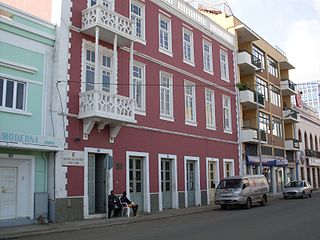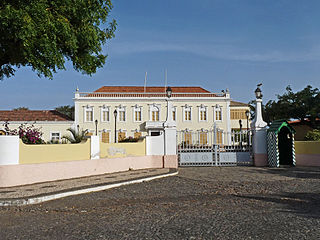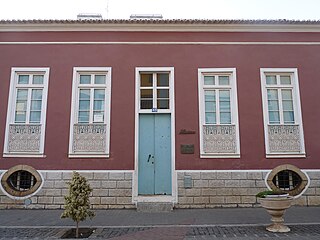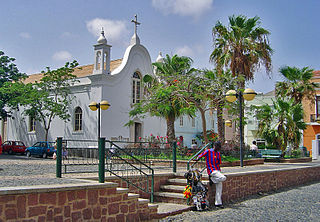
Praia is the capital and largest city of Cape Verde. Located on the southern coast of Santiago island, within the Sotavento Islands group, the city is the seat of the Praia Municipality. Praia is the political, economic and cultural center of Cape Verde.

Mindelo is a port city in the northern part of the island of São Vicente in Cape Verde. Mindelo is also the seat of the parish of Nossa Senhora da Luz, and the municipality of São Vicente. The city is home to 93% of the entire island's population. Mindelo is known for its colourful and animated carnival celebrations, with roots in Portuguese traditions later influenced by the Brazilian culture.

The Palácio da Presidência da República is a public building in the city centre of Praia, the capital of Cape Verde. It is situated on Rua Serpa Pinto, at the south end of Plateau, the historic district of Praia. It was constructed around 1894 in neoclassical style as a residence of the Portuguese governor of Cape Verde. After Cape Verde gained independence in 1975, it became the presidential palace.

Avenida Marginal is an important street in Mindelo, São Vicente island, Cape Verde. It runs along the coast of the Porto Grande Bay, connecting the city centre with the northwestern outskirts (Matiota). Its southern end is the intersection with Rua Libertadores de África and Rua da Praia, that continues south along the coast. Avenida Marginal runs along the port of Mindelo, below Fortim d'El-Rei and along Praia da Laginha in Matiota.
Red Cross of Cape Verde, abbreviated CVCV, was founded in 1984. It has its headquarters on Avenida Andrade Corvo in Praia, Cape Verde.

Quartel Jaime Mota is a historical building in the historic city centre (Plateau) of Praia, Cape Verde. It is situated at the southern end of Avenida Andrade Corvo, near the Presidential Palace of Cape Verde. It was built between 1823 and 1826 as a military barracks. The present structure in Neo-Manueline style dates from 1872, and was further expanded and modified in the late 19th and early 20th century. After independence, it was named after Jaime Mota, a Cape Verdean militant of PAIGC who was killed in Portuguese Guinea.

Museu Etnográfico da Praia is an ethnographic museum in the Cape Verdean capital of Praia on the island of Santiago. It is located at 45 Rua 5 de Julho, in the historic part of the city, the Plateau. The museum was opened in November 1997 and is located in a 19th-century building. The museum contains a selection of objects that represent the traditional uses and customs of the Cape Verdean people.

The Pro-Cathedral of Our Lady of Grace is a catholic church on the east side of Praça Alexandre Albuquerque, in the city centre of Praia, on the island of Santiago, Cape Verde. The church was built between 1894 and 1902. It is the seat of the Roman Catholic Diocese of Santiago de Cabo Verde, which was created in 1533. It is under the pastoral responsibility of Arlindo Gomes Furtado Cardinal.

Plateau is the historic centre of the capital city of Praia on the island of Santiago, Cape Verde. It gets its name because it is situated on a plateau overlooking the port of Praia. Its average elevation is 37 meters above sea level. The population of Plateau was 1,019 at the 2010 census. Many public buildings are situated in Plateau, notably the Presidential Palace, the cathedral, the city hall and the Ethnographic Museum.

Chã de Areia is a subdivision of the city of Praia in the island of Santiago, Cape Verde. Its population was 247 at the 2010 census. It is situated south and west of the city centre. Adjacent neighbourhoods include Plateau to the northeast, Achadinha to the north, Várzea to the west, Achada Santo António to the southwest and Prainha to the south. Its main streets are Avenida Combatentes da Liberdade da Patria and Avenida Cidade de Lisboa. Points of interest in Chã de Areia include the beach of Gamboa, the old port of Praia and the Cape Verdean National Archives, housed in the former customs building.

Praça Alexandre Albuquerque is the main square of the capital city of Praia, Cape Verde. It is located in the southwestern part of the Plateau, the historical city centre of Praia. Formerly known as Praça do Pelourinho, it received its current name in 1876 in honour of the Portuguese colonial governor Caetano Alexandre de Almeida e Albuquerque. It is lined with several historical public buildings and townhouses, many of which date from the 19th century. The square is surrounded by Rua Patrice Lumumba, Rua Serpa Pinto and Avenida Amílcar Cabral.

GimnodesportivoVavá Duarte is a multi-purpose stadium in Praia, Cape Verde south of the city center's plateau in the subdivision of Gamboa just south of Várzea and is located on Avenida de Cuba, a road connecting the south of the city and the north and the southwest of the island. It is currently used for basketball, volleyball and futsal matches. The arena are operated by the Santiago South Regional Basketball Association for basketball, the Santiago South Regional Volleyball Association for volleyball and probably the Santiago Regional Futsal Association for futsal. These associations are also headquartered in the arena and around it.

There is also Rua Serpa Pinto in the neighbourhood of Mártires in Lisbon, Portugal

Avenida Amílcar Cabral is an avenue in the Plateau, the historic centre of Praia, Santiago island, Cape Verde. It is the neighborhood's longest street and the main artery of the city centre. Formerly named Rua Sá da Bandeira after 19th century Portuguese politician Sá da Bandeira, it was renamed after Cape Verdean independence in honour of Amílcar Cabral, leader of the independence movement of Cape Verde and Guinea-Bissau. It runs south to north in the western part of the Plateau, parallel to Rua 5 de Julho, Rua Serpa Pinto and Avenida Andrade Corvo. It forms the west side of Praça Alexandre Albuquerque.

Quintal da Música, abbreviation: 5tal da Música is a music pub located in the downtown area of Praia, the Plateau and is located at 70A Avenida Amílcar Cabral in the northern part of the center, across Rua António Pusich and south of Rua António Macedo. It is one of the most famous and most used pubs and music pubs in Cape Verde.

The City center of Mindelo or Morada is the historic center of the Mindelo in the island of São Vicente, Cape Verde. Its population was 1,553 at the 2010 census. It is the place where the island's first settlement was founded in 1793. Many public buildings are situated in the city centre. It lies along the Porto Grande Bay. Adjacent neighbourhoods include Fortinho to the northwest, Alto Miramar to the northeast, Fonte Cônego to the east and Ribeira Bote to the southeast.

Rua 5 de Julho is a street in the Plateau, the historic centre of Praia, Santiago island, Cape Verde. Formerly named Rua D. Luís after King Luís I of Portugal, it was renamed after 5 July, the independence day of Cape Verde (1975). It runs south to north, parallel to Avenida Amílcar Cabral and Rua Serpa Pinto. Praça Alexandre Albuquerque is at its southern end. It has been pedestrianised in the early 21st century.

Avenida Cidade de Lisboa is an avenue west of the center of Praia, Santiago island, Cape Verde. It runs along the neighbourhoods of Várzea, Achadinha and Chã de Areia. It is one of the major arterial roads of the city. The street is named for Praia's town twinning with the city of Lisbon, Portugal. It runs south to north, west of the Plateau. The annual carnival parade takes place on Avenida Cidade de Lisboa.

The Architecture of Cape Verde has different architectural styles. Unlike the African mainland, Cape Verde was uninhabited until 1461 when the Portuguese arrived, whereas most of the other islands were first inhabited after the end of the 15th century. Its architecture was introduced in the 1460s and has its first origins from Portuguese settlers from the Madeira Islands. The Manueline was its first architectural style, and was followed by Renaissance, Baroque, Pombaline, Early Modern and Modern.

Praça Luís de Camões is the second main square of the capital city of Praia, Cape Verde. It is located between Rua Serpa Pinto and Avenida Andrade Corvo in the eastern part of the Plateau, the historical city centre of Praia. The square is named after the 16th century Portuguese writer Luís de Camões.



















